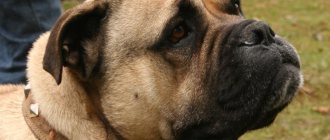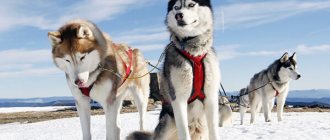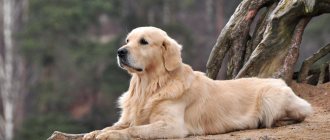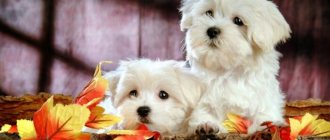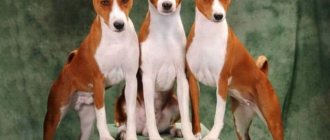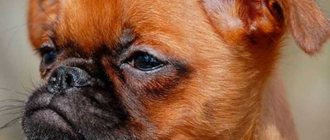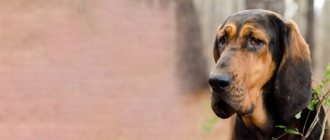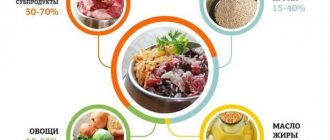Description of the breed
Ca de Bou dogs amaze anyone who sees them for the first time. And there are reasons for this, because they have impressive mass, muscles and a charming wide smile. Perhaps in this way they demonstrate their friendliness and openness . Although in reality this breed was able to gain high popularity for completely different reasons: they ideally combine watchdog qualities, balance and the ability to adequately assess the situation. Therefore, Ca de Bou behaves depending on the development of the situation and can easily recognize who is a friend, who is an enemy, and who ended up here by chance.
These animals are known by several names:
- major mastiff;
- perro de presso mallorquin;
- perro dogo mallorquin.
It is logical that the homeland of these animals is Mallorca. The name fully corresponds to them, because in translation it means “bull dog”. Ca de bou are quite confident dogs, which they demonstrate with good reason. Knowledgeable people know that at one time these dogs took part in the favorite Spanish entertainment - bullfighting. These animals needed to provide protection to bullfighters , so they had to be ready at any time to engage in a fight with a bull. But how could this medium-sized dog gain the upper hand or prevent a large, strong opponent from tearing a person apart? Thanks to the iron, death grip.
Ca de bou are excellent for the role of security guard and bodyguard due to their excellent reaction, but at the same time they can also become a pet. You should not expect any unexpected actions towards household members from this dog. These animals demonstrate friendliness and affection, quickly establishing friendly contact with all family members, so even families with children can have them.
A distinctive feature of the Ca de Bou is that they do not single out the leader of the pack among the people living in the house, in order to be loyal only to the owner . They share their tenderness and care with everyone equally. Ca de Bou show admirable patience towards guests and family friends, but if the owner is absent for a while, they will not allow anyone to enter the house, even if it is someone they know.
Typically, these dogs do not behave aggressively unless there is a reason for it. You can raise a puppy into an excellent guard and an excellent friend if you start raising it from puppyhood. Particular attention should be paid to walks, since without them it is impossible to raise a healthy and strong animal. You will also have to often arrange field trips and organize outdoor games. However, you yourself will have a lot of fun playing with this giant. It is very easy to communicate with him, because they are very smart, quick-witted animals that do not create difficulties in training.
Maintenance and care
Mallorcan puppies arrive at the home of a new owner at the age of 1.5-2 months. Dog handlers do not recommend having a dog for those who live in an apartment. She needs freedom.
The best option is a country house. If home is not possible, you should provide your pet with long walks with intense physical activity. In this case, the dog will be able to spend its energy reserve. The breeder must think about whether he is able to provide this condition and only then make a decision.
Features of keeping a Major Shepherd are determined by the age and length of the dog’s coat. Short-haired representatives are easier to keep. Care is kept to a minimum: feeding, walking, combing.
Attention! If you plan to keep a dog in an apartment, give preference to the short-haired variety.
- The dog's ears need to be cleaned. The procedure is organized 2-3 times a week. Also, pets’ teeth are brushed weekly with special pastes or devices.
- Nails will need to be trimmed. Representatives of the breed require manipulation with a nail clipper. Pruning is carried out once a month.
- Large dogs are usually not bathed, but if the pet gets dirty during a walk, it needs to be bathed.
How to Trim a Dog's Nails?
Veterinarians strongly recommend trimming the nails of your four-legged pet, but how to cut ... Read more
Feeding
The question of what to feed the Mallorcan Shepherd will always be relevant for breeders. Owners who have little time often choose premium ready-made food. Please ensure that the packaging indicates that the food is intended for active breeds.
The best option is to consult a veterinarian. The specialist will recommend a brand of dog food that will provide your pet with the necessary substances and trace elements.
Feeding with homemade products is allowed. This does not mean that the dog will eat your food. She'll have to cook. The diet of an adult includes:
- offal;
- lean meat;
- fish fillet;
- cereals;
- dairy products;
- vegetables.
Dog handlers claim that these dogs are indifferent to fruits. It is enough to add boiled carrots or other vegetables to the porridge. Among cereals, preference should be given to buckwheat, oatmeal, and rice.
Meat and offal are pre-boiled with boiling water. This is done to prevent the dog from hunting poultry or livestock.
Flour products and sweets are prohibited. Treats will lead to an excess of energy. The dog will become overly active and mobile.
Training
A Mallorcan puppy arrives at the breeder's home at the age of 1.5-2 months. Then the first lessons begin. The new family member is taught a name, place, and toilet.
You can teach your dog simple commands on your own. But serious training of the Mallorcan Shepherd should be carried out by a person with professional skills.
She needs a strong owner with a strong character. The pet must clearly understand who is in charge in the house. The breeder should not show any weakness of character under any circumstances. Otherwise, this will lead to the dog growing up uncontrollable and aggressive. Keeping her near people would be dangerous.
It is strictly forbidden to own this breed for the sake of fun or prestige, as well as for those who have decided to own a dog for the first time.
Ca de bestiaries are very smart. They remember up to 100 commands, pick up voice intonations, and clearly divide all people into “us” and “stranger.”
Additionally, the training process may vary depending on the purpose of keeping the dog. The Spanish Shepherd is taught to herd a herd, guard a house, participate in battles, or catch criminals.
Dog handlers say that this is, first of all, a working breed. The dog needs to be involved in human activities. Then she will find an outlet for her energy and will meet the owner’s expectations.
Major Shepherd: photo
Photos of Ca de Bestiar convince us that the breed is not suitable for keeping in an apartment. The dog needs space.
Spanish Shepherds have beautiful, black, shiny coat. By the way, shine is an indicator of health and proper nutrition. These are beautiful, dexterous, active and hardy dogs. They need an owner with a strong character and an active lifestyle. It is better for couch potatoes to give preference to another breed.
The Mallorcan Shepherd makes an ideal friend and bodyguard, provided it has been raised properly. Realistically assess your options before making your final decision.
Types, standards and varieties
By external features, these dogs appear to be strong, massive animals of the molossoid type, with a slightly elongated body, a large head and a wide muzzle . But it is their overall mass and developed muscles that allow them to seem like such large dogs, although in reality they are not. In principle, in terms of size, they can be classified as medium-sized dogs. Males, as a rule, have a height at the withers of 55-58 cm, and females - 52-55 cm.
Depending on the gender, dogs of this breed may exhibit minor differences. However, in general they are very similar, primarily in their coat, which is short and harsh. Within this breed, it is customary to distinguish several types of color:
- motley (brindle);
- deer (red, beige);
- black.
Choosing a Ca de Bou puppy
Although dogs of this breed have impressive characteristics, not everyone should own one. First of all, you must answer the question of whether you are ready to take full responsibility for caring for these animals. You need to understand whether you can provide the necessary living conditions, allocate enough time for care and walks, and whether you can properly build a relationship with such a large and strong-willed animal.
If you still remain true to your decision, then it is best for you to contact a specialized nursery . But the bird market is the most inappropriate place for this. If you can find a reputable nursery, then they will even offer you to meet the mother of your puppy, the living conditions of the animals, and, in addition, you can hope that the breeder will provide you with any possible assistance after the purchase.
But before choosing a Ca de Bou puppy from a kennel, we advise you to go to several specialized exhibitions. There you will have a great opportunity to get acquainted with these dogs, as well as get the necessary information from the breeders of the breed. You can get valuable information from catalogs: they will help you decide on the most preferable related lines.
Recommendations for selection
One of the main questions that you must answer is for what purpose are you buying a dog . If you need a Ca de Bou to become a family favorite and protect you and your home, then you should choose a puppy based on personal preference and a pragmatic approach. This means that you need a puppy who has a balanced character and good health. Completely different criteria should be used as the basis for your choice if you are going to purchase a dog for a show career.
Education and training
The Major Mastiff, despite its phlegmatic character, needs a responsible owner who can create competent training programs. But not everything depends on the owner: primary socialization takes place in the nursery where the puppy was born, so it is important to be confident in the integrity of the breeder.
Raising and training Ca-de-Bo should begin at two months, in particular, from the moment when the animal first finds itself in a new home. It is important to show the puppy the internal “hierarchy” and the boundaries of what is permitted.
It wouldn’t hurt to communicate with older, well-mannered and trained four-legged friends. Training should become more difficult in proportion to the age of the animal. Carefully practice the desired habits, since they can be easily corrected only in the first year of the animal’s life - during the most active period of brain development.
The little Great Dane often rebels, testing the owner's strength: he chews furniture, goes to the toilet on the carpet, or does something similar. Owners, frightened by such behavior, take the animal to a dog handler. But everything is simpler: the animal simply tests the owner’s endurance.
It is recommended to take the obstinate dog to group classes, where he can meet more well-mannered dogs and learn the basics of good behavior. The ideal solution would be to attend OKD or UGS courses.
Looking for a ca-de-bo? Find your pet from 1 offer Buy
Features of maintenance, care, health
All representatives of the breed are short-haired animals, so it will be quite easy for you to care for them. The first thing you must learn is that your dog needs to be brushed regularly with a rubber brush . This will help not only maintain her well-groomed appearance, but also maintain her health. But you should not get carried away with bathing - this procedure can negatively affect the natural fat balance of the skin. However, even if you cannot avoid washing your dog, it is recommended to use professional products designed for wire-haired dogs.
You will also have to take care of the claws - they need to be trimmed regularly. Don’t forget about the ears and eyes, which need to be examined periodically. To keep your ears clean, you need to remove all dirt from them at least once every two weeks using cotton swabs or swabs. At the first sign of suspicious discharge or an unpleasant odor in your dog’s ears, you should immediately take your dog to the veterinarian for an examination. Proper eye care for your dog is very important . This is done using cotton wool, which is soaked in a special lotion.
Regularly monitor the condition of your pet's teeth. If you notice signs of tartar formation, then you need to contact a veterinary clinic. You can prevent this problem by giving your dog cartilage, chewing bones, and special toys for cleaning teeth. You need to be especially attentive to your dog’s mouth at an early age - you must be sure that the puppy’s bite is forming correctly.
Education and training
Dogs of this breed are distinguished by their developed intelligence and intelligence, and do not create much trouble in training and training. But so that you can quickly see the results of your work, you need to start working with the puppy in the first days of his stay in your home. First, you need to teach him simple commands - “come to me,” “sit,” “place.”
An adult pet will not cause problems if you notice any changes in behavior and respond accordingly. You must prohibit the puppy from doing things that you would not want to see in an adult animal. Seeing how the puppy is trying to take a dominant position, you should immediately do everything to prevent this from happening. If you and your pet have a serious problem that you cannot solve on your own, then you. It may be worth seeking the help of an experienced trainer. If you train a dog of this breed correctly, you will enjoy interacting with it. Moreover, she will not cause you disappointment, and the children will find a loyal, honest and cheerful friend in her.
Nurseries and clubs
The first domestic dog breeders became acquainted with Ca de Bou in 1992. Our country managed to become a leader in the breeding of these dogs relatively recently. A landmark period was 1997, when the National Ca de Bou Club . It did not take him long to achieve recognition from the Spanish Association of National Breeds. Most of the kennels involved in breeding dogs of this breed in our country are concentrated in Moscow.
Our family is the happy owner of a Ca de Bou dog. Our pet Argo has been living with us for 4 years now. Despite her small size for a large dog, she feels great in our apartment. This is a very kind animal that always treats children with affection. As soon as a child starts crying, the first one who rushes to his aid is our pet. Argo is very easy to care for with his short coat . He is not picky about food and enjoys eating porridge with meat. After a walk, you don’t have to force him into the bath to wash his paws off the dirt. We have never seen any signs of aggression from him; our pet is even friendly towards strangers.
When I found out about this breed, I didn’t find a single negative review about it, so I decided to get this particular dog. But in order to please our daughter, who dreamed of an Amstafa, we chose a black Ca de Bou, which is a bit reminiscent of an Amstafa . My daughter liked my decision. It’s already been 5 months since this girl has been living in our apartment, and my daughter already treats her differently. If we want to get another dog, it will definitely be a Kadeboshka. Dami has become a new member of our family whom we love very much. This is an excellent option for an apartment, because it is small in size, very obedient and incredibly loyal.
This dog came to us recently - only 2 months ago. We took him in as an adult puppy, when he was 6 months old, but we still found a common language with him. I would like to express special gratitude to the breeder who taught him the basic commands. But we continue to train him ourselves. We are literally amazed at how quickly she picks things up. She especially likes to play.
We often go somewhere with her to play ball and try to catch up with each other. At such moments the dog looks especially happy , it seems that a smile appears on his face. At the same time, it is an excellent guard. He reacts perfectly to any person who walks along the entrance and emits a menacing growl. However, a couple of moments pass, and she again becomes a calm and good-natured dog.
Advantages and disadvantages
- Pros:
- good security qualities;
- phlegm;
- low shedding and easy care;
- peacefulness;
- calm attitude towards children and other animals;
- affection for all family members.
- Minuses:
- dominant character;
- a small number of nurseries where you can buy a purebred puppy;
- high physical activity requiring walking;
- high cost of maintenance.
Features of the breed and character of Ca de Bou
When you see a Kadebo dog , you may mistake it for a rather aggressive creature - this is not surprising, since the huge body mass, muscularity and sharp teeth hardly make one think about the friendliness of the animal.
But in fact, this attitude is unfair, since dogs of this breed have a large number of fans around the world thanks to the ideal balance of security skills, calmness and the ability to quickly assess the situation. It is worth noting that in many descriptions of the Cadebo one can find the following names for this breed:
- Mallorcan Mastiff;
- perro dogo mallorquin;
- pero de presso mallorquin.
But due to the difficulty in pronouncing these names, the most widely used is ca de bou. From the above names it is not at all difficult to guess that the breed first appeared in Mallorca, and its name translated means “bull dog”. This translation is due to the fact that in the old days these dogs were obliged to protect bullfighters from angry bulls.
So, the Ca de Bou dog is an excellent hunter who, being in the circle of his family, quickly adapts and becomes friendly and affectionate. These dogs never single out one owner in the family; they pay attention to everyone, thereby proving that there is enough love in their hearts for everyone.
They treat strangers wonderfully (family friends, relatives), but in the absence of the owners they will never let even familiar people into the house. Without a proper reason, this type of dog will never bark, which is what attracts older people.
As a rule, it is not in the character of a dog to show causeless aggression, but in order to avoid unforeseen situations, you need to train the dog almost from birth.
At the same time, raising a dog should be done by a person with a strong character, otherwise it’s a disaster, maybe he simply won’t obey. Dogs of this breed will never offend a weaker dog, and they try to avoid fights with animals of their category, but not because of cowardice, but because of their balance.
By the way, if you have children in your family, then this particular breed of dog will get along best with them. Kadebos will even tolerate riding on their own back without complaint and even get some pleasure from it.
The photo shows a puppy of the Ca de Bou breed
Price and reviews
Ca-de-bo is a dog breed that is in the middle price range.
- The cost of a puppy is from 25 to 35 thousand rubles.
- If the baby has an elite pedigree, then its cost will reach 50 thousand rubles.
- Expensive, but the dog is worth it, because the reviews about Ca-de-Beau are mostly positive.
Animals with defects cost slightly less, about 10-15 thousand rubles.
Description of the Ca de Bou breed (standard requirements)
In appearance, dogs of this breed are quite strong, massive, their body is slightly elongated, they have a large head and a wide muzzle. As a rule, due to their overall weight and developed muscles, ca de bou appear much larger than they actually are.
According to the standards, they are classified as medium-sized dogs. Normally developed adult females should have a height at the withers of 52 to 55 centimeters, and males - from 55 to 58 centimeters. It is worth noting that even in various photos of ca de boux , males and females differ significantly from each other. The main difference is the size of the head; it is much larger in males.
They have a thick neck, which looks proportional to the whole body. The chest is cylindrical, deep set. The stomach is taut. The tail is set low, quite wide, but there is a narrowing towards the tip (docking the tail of a cadebo is strictly prohibited).
Eyes of dark shades, from coffee to black. The coat of representatives of the Ca de Bou breed is short and stiff. True representatives of the breed have the following colors:
If any impurities are present, then it is likely that the dog is not purebred. Occasionally there may be markings on the face, paws and back - white or black. The life expectancy is from 10 to 12 years, with proper care they can live even 15 years.
Interesting Facts
- Ca-de-bo needs regular veterinary examination.
- Frequent bathing is harmful to the molosser.
- Puppies require homemade natural food.
- Ka-de-bo loves to play ball.
- The cost for mating is determined by the owner of the dog.
At one American customs office, two dogs of this breed were on duty, which accurately identified drugs in luggage. Mexican drug dealers placed a reward of 30 thousand dollars on their heads. Stories about the bloodthirstiness of the ca-de-bo are the result of improper training of dogs.
Care and maintenance of ca de bou
Since this breed is a short-haired dog, it does not require special care. In order for a cadebo to have a well-groomed and shiny coat, it needs to be cleaned regularly (every few days) with a brush; a rubber one will do just fine.
It is recommended to avoid frequent water procedures, as this can lead to disruption of the animal’s natural skin fat balance. If you still need to bathe the animal, then it is advisable to spare no expense and buy a professional bathing product for wire-haired dogs.
In the summer, you can let the animal swim in the river. Dogs' nails also need to be trimmed regularly, as excessive length can lead to health problems. In addition, the animal will damage furniture and floors.
You should constantly examine your dog's eyes and ears, and the latter should be cleaned at least once every few weeks with a cotton swab. If you notice foul-smelling discharge or just discharge from the ears, you need to immediately take your dog to the veterinarian. The eyes also need to be constantly wiped with special swabs.
In addition, it is recommended to constantly check the condition of your pet’s teeth in order to notice the formation of tartar in time, since this is a fairly common occurrence for representatives of this breed.
Kadebo is a dog breed that requires daily walks. If you don’t have the opportunity to constantly walk your pet, then send it to some kind of sports activity, where you will take the dog on weekends, and where it will have the opportunity to run for fun.
Description of the Ca de Bou breed
The Mallorcan Bulldog or Ca de Bou is a very famous Spaniard in canine circles.
Initially, the dog was created to participate in battles, so the corresponding qualities were brought up in it. In addition, the Ca de Bou breed was designed to protect bullfighters from bulls. When dog fighting was banned, some owners tried to use it as a kind of weapon in criminal cases. But there were also those who decided to cultivate more goodwill in the dog.
Flaw in the breed
Deviation from the standard characteristics of the breed is a flaw in a purebred dog.
Defects found in ca-de-bo:
- Absence of dental premolars;
- The gap between the teeth is more than 10 millimeters;
- The height of the withers is greater than the height of the sacrum;
- Uncharacteristic ears for the breed;
- Atypical bite;
- Non-standard tail shape, reminiscent of a bulldog.
Disqualification occurs on the following grounds:
- The iris of the eyes is a light shade;
- More than 30% of the coat is covered with white spots;
- Cowardly or aggressive behavior;
- Ears or tail docked;
- The testicles are not descended;
- Bite not typical for the breed.
Description of the breed
Ca de Bou dogs are very strong, physically developed, powerful pets. They belong to the Molosser category. They are not very tall, considering that they had to fight bulls, about 52–58 cm. They weigh on average 30–38 kilograms, but if the dog is not fed correctly, it can quickly exceed these standards.
The dog's body seems elongated. The head is large, the muzzle and forehead are wide. The frontal groove is very pronounced, which makes the transition from forehead to muzzle somewhat abrupt. The slightly upturned muzzle has a black nose with wide nostrils.
The dog's lower lips form a kind of fold, due to which the teeth are not visible when the mouth is closed. The gum color is pink with possible black pigmentation. Oval large dark eyes are set wide apart, slightly above the line of the nose.
Ca de Bou has very unusually shaped ears. The characteristics of the breed indicate that they should be high on the head, slightly pulled back. In this case, the tips should be below eye level.
The dog's back is not straight, its hind end is higher. The abdomen is retracted, which creates the feeling that the dog has been pulled in around the conventional waist. Limbs of medium length, which do not have much muscle. The paws are oval in shape.
The tail is of medium length, thick, hangs down to the middle of the hind legs, and is set high. At rest it is usually lowered or slightly curved.
Possible dog coat colors: brindle, red, fawn, black. There can also be any shades of red. But at the same time, all versions of dogs, except black, must have some kind of “mask” on the face. The coat is short and harsh.
The Major Bulldog lives on average 10–12 years. If you provide appropriate care for him, he can live a long life.
Before you buy a puppy of this dog, you should definitely look at their mother. This will create the correct impression of the dogs' conformity to the breed. At 1.5 months it is already clear how well the puppy can withstand the requirements of the standard and what kind of character it has. Therefore, you can choose a dog from this age. A litter usually produces 6–8 puppies.
Pet health
The descendants of Major Molossians have excellent health. In nurseries, puppies are vaccinated against plague, hepatitis and other dangerous diseases. Vaccination should be updated every year.
- Some diseases are still inherent in this breed of dogs: food allergies, joint disease, liver disease (hepatopathy), demodicosis, which is a dangerous disease of the skin and internal organs caused by mites, myositis—inflammation of the muscles.
- It is important for Ca-de-Beau to lead an active lifestyle to prevent the appearance of excess fat. Your pet's teeth need to be brushed at least twice a month, using special zoopastes, since toothpastes for humans can cause allergies in the dog.
- You should comb your pet during shedding, and also treat it against external and internal parasites. Perform eye examinations daily. If foreign particles or nitrous appear, carefully remove. You can use a lotion designed for this purpose or a strong tea leaves.
As a rule, pregnancy and childbirth in Ca-de-Beau go well, but some rules should be followed:
- Do not breed during the first heat;
- Provide the expectant Molosser mother with adequate nutrition, medications and a positive atmosphere;
- Create favorable conditions for the life of puppies.
Character of the breed
When they first see this dog, many people think that it was created only to participate in fights with its relatives and is not capable of affection. In fact, modern ca de bou are very sweet and even loving creatures.
They adapt well to different environmental conditions. These are very active dogs, so they will get involved in all family activities and are very happy if they are invited to play together. The dogs are quite self-possessed, patient, even during a walk, if they meet other relatives, they will not succumb to provocations and enter into a fight.
Ca de bou are excellent guards of property and people. Moreover, they are always ready to warn about danger, but barking for no reason is not typical for them.
The desire to move is so strongly developed in them that sometimes the owners get tired of it. However, you should show restraint and allow the dog to splash out its energy during a walk.
They will be happy to accompany their beloved owner on his travels, even if it involves a lot of walking.
The Ca de Bou dog breed is highly trainable. Accepts commands quickly, but only through encouragement. If you are rude to her, if you hurt her, she will harbor a grudge. The training course should include various jumps, which the Majorcan Bulldog really likes.
Gets along great with children. A dog is capable of not only protecting them, but also raising them. There are no problems in her living together with other animals. True, most likely, she will try to take the place of leader among other pets.
Features of feeding and diet
Ca-de-bo nutrition is a frequently discussed issue on forums. If the owner does not have the opportunity to visit a doctor or consult a canine specialist, then you can read the guide on feeding a puppy or an adult dog written about this breed.
The basis of the diet can be natural food or dry food. In any case, the norms for the intake of proteins, fats, carbohydrates and calories must be observed, and the health characteristics of the animal must also be taken into account.
The number of feedings and the size of portions depend on the age of the individual. A one-month-old puppy should receive small handfuls of food six times a day, a five-month-old baby should receive three small portions, and an adult dog should receive two fairly large portions.
Natural nutrition is the most difficult to “execute” due to the need to constantly monitor the quantity and quality of nutrients entering the body. On this type of diet, the mastiff can be given the following food groups (mainly of animal origin):
- lean red meat;
- poultry meat (chicken, turkey);
- rabbit meat;
- offal;
- low-fat sea fish, boneless;
- fruits, berries (except for fruits with seeds and citrus fruits);
- vegetables (peas, cabbage, beans are excluded);
- vegetable oils;
- fermented milk products with a low fat content;
- whole grain crops.
The dry type of food involves feeding one type of food (necessarily premium, since cheaper analogues often contain substances harmful to the dog).
The owner decides what food to feed the dog: after moving to a new home, for one month the puppy eats the same food as in the kennel, and then the owner can change it. It is important to choose the right food so that it covers the dog’s energy costs and maintains its appearance in proper condition. If the animal has undergone medical intervention or acquired a chronic disease, the veterinarian selects food adapted to the new needs of the body.
